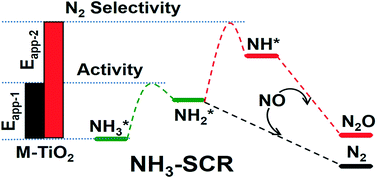Theoretical design of transition metal-doped TiO2 for the selective catalytic reduction of NO with NH3 by DFT calculations†
Abstract
Many transition metal oxides supported on TiO2 have been studied for the selective catalytic reduction (SCR) of NO with NH3. However, a trade-off exists between the low-temperature activity and N2 selectivity. To identify the critical factors influencing the activity and N2 selectivity, we chose a series of metal (V, Cr, Mn, Fe, Co, Mo, and Ce)-doped TiO2(101) slabs to investigate the NH3-SCR mechanism by the DFT method. The reaction energy and barrier of every elementary step via the N2 and N2O formation paths were calculated. The apparent activation energies for N2 (Eapp-1) and N2O (Eapp-2) formation can represent the activity and N2 selectivity, respectively. The obtained Eapp-1 and Eapp-2 for all the 3d and 4d transition metal-doped TiO2 catalysts suggested that Mn-, Co-, Ni-, Cu-, Zn-, Pd-, Ag-, and Cd–TiO2 had good low-temperature activity, while TiO2, Cr-, Fe-, Zr-, and Ce–TiO2 had high N2 selectivity. Besides, the linear relationships between Eapp-1, Eapp-2, and the surface oxygen activity indicated that the doping of transition metals affects the surface oxygen activity by the doping effect, electronic structure, and atomic size, leading to different activity and N2 selectivity. This study built a simple model to design transition metal-doped TiO2 with good low-temperature activity and N2 selectivity, which has significance for designing excellent SCR catalysts for practical application.



 Please wait while we load your content...
Please wait while we load your content...